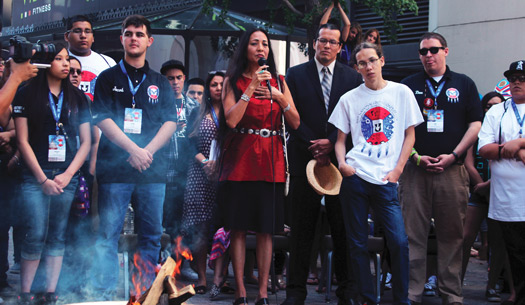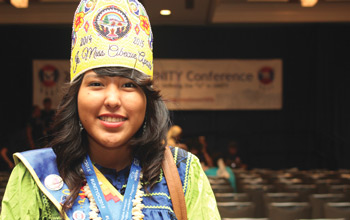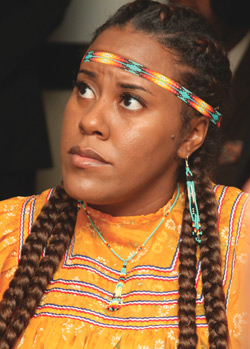'We are still here' - Unity conference gives native youth lessons from the past and a foundation for the future
By Richard B. Muhammad - Editor | Last updated: Jul 21, 2015 - 11:16:08 AMWhat's your opinion on this article?

Unity executive director Mary Kim Titla at lighting of ceremonial fire during Native American youth gathering in Washington, D.C. Photos: Hasaan Muhammad
|
WASHINGTON—The fire outside of the Renaissance Hotel, contained in a brass pit, offered a different kind of warmth for mid-July.
The lighting of the fire opened the Unity (United National Indian Tribal Youth) gathering as part of a sacred cultural tradition with fire as a gathering place for truth, for healing, for spiritual connections and strengthening the bonds of relationships.
At the fire, an elder spoke of native youth attending the conference who lost someone back home to suicide. The death mirrored one of the statistics that Native American young people face and some of the harrowing conditions to be overcome. But it was not the definition of the experience of the original people of this nation, and there was a strong feeling and powerful acknowledgement: “We are still here.”

Pride in native culture and heritage is a major part of the annual Unity conference.
|
Despite genocide, forced marches, schools dedicated to the sadistic destruction of their identities, smallpox in blankets, alcoholism, broken treaties and theft of their lands, “We are still here” was a defiant and proud declaration for young people at a conference devoted to their future.
Unity was founded 37 years ago by J.R. Cook and every year the group hosts an annual conference. Young Indians, ages 14-24, spend days together working on their mental, spiritual, physical and social development. Sessions focus on culture, identity and challenges like drugs, gangs, sexual trafficking of native women and girls alongside education, health, careers and leadership development. There is cultural dancing, exercise and this year included a 3 on 3 basketball tournament.
The Honorable Minister Louis Farrakhan was cheered and applauded during a message delivered at a Unity plenary July 10 session. He spoke the day after first lady Michelle Obama spoke to young people at the White House during a first ever White House gathering of tribal youth. Congressmen and federal officials also spoke to young people. Native American actor Adam Beach also attended this year’s conference.
Min. Farrakhan talked about the value, deep history and longtime oppression of the indigenous people of America and the need for Native American youth to embrace and pursue a deep understanding of who they are to reclaim their land, restore the Red Nation and create a future for themselves and their people.

Yo Nas Da Lonewolf
|
About one-in-four American Indians and Alaska Natives were living in poverty in 2012 and for those who identify as American Indian or Alaska Native as their only race, the poverty rate was 29.1 percent in 2012, according to a Pew Center survey.
According to the National Indian Child Welfare Association, there are 5.2 million American Indians and Alaska Natives living in the United States—making up 1.7 percent of the total population. Just over a third of the populations is under age 18 with American Indian children suffering high rates of maltreatment; suicide is a leading cause of death for Native American teenagers and young adults and Indian youth suffer higher rates of anxiety, substance abuse, alcoholism and depression. These youth also are more likely to be involved with gangs, the association reported.
According to one estimate, since the inception of the United States, some 1.5 billion acres of land has been taken from native peoples.
Unity is a refuge and a leadership incubator for native youth—who may still face fights because of taunts and insults or conflicts when others automatically assume they are mixed-race, Latino, Puerto Rican or Black. There are still the insults over so-called Thanksgiving holiday, which makes a mockery of the slaughter of the original inhabitants of this land. There are threats to tribal sovereignty which can make punishing non-natives for crimes against native women difficult at times, environmental threats left after mining operations or excavation of precious and rare minerals or metals.
Then there is the problem with police and courts: According to a report by the Lakota People’s Law Project, Native Americans are most likely to be killed by law enforcement. Native youths suffer the two most severe outcomes of the juvenile justice system—out of home placement and transfer to the adult penal system. Native Americans are more likely to be victims of violent crimes perpetrated by non-Native people than any other group. Native American youth is 1 percent of the youth population, but represents 70 percent of the youth admitted to the federal bureau of prisons.
At the Unity conference, which drew over 1,800 native youth and indigenous representatives from Taiwan and New Zealand, pride and support is in abundance. Advisors and chaperones and even Unity executive director Mary Kim Titla become “Unity moms” and “Unity aunties” to young attendees. The notion of extending family beyond blood relations is strong here and among many tribes.
Others noted the similarity between native words, customs and dialects though the tribes were different. The similarities showed the native people were really one nation, they said.
Some participants drove days to attend the conference stopping at historic sites along the way, and planning to stop at places like the federal government’s Indian school in Carlisle, Penn., which was a chamber of horrors for native youth in the 1930s who were stripped of their names and identity, punished for speaking their language, and forced to try to become Red versions of White men. They were physically and sexually abused and sought solace in alcohol, and brought these negative patterns back to their reservations, said a youth advisor.
Rico, a member of the Piscataway tribe, called a plenary session, a great day. “We have been able to survive in the belly of the beast. We have been here 15,000 years, 30,000 years. We have no plans to go anywhere. We honor this place we call home and we welcome this people, he said. The Piscataway, a Maryland tribe, was the host nation for the Unity gathering.
Nichole Manuel of the Toriono O’odham Nation from Florence, Ariz., sees Unity as a special place to bond and embrace her heritage. The embrace is non-intergenerational with her teenage daughter among a group of youth Ms. Manuel brought to the conference.
Yo Nas Da Lonewolf, who is Lakota and Black, represented the Nation of Islam and Min. Louis Farrakhan at the conference along with Student Minister Abel Muhammad. She facilitated the Minister’s appearance at the conference. Her mother Wauneta Lonewolf was a respected leader, friend of Min. Farrakhan and helped create relationships between the Nation and the Native American community. Her daughter continues to do that work.
The Minister’s address to youth was historic and important as organizing moves ahead for the Justice Or Else! gathering planned for Oct. 10, 2015, she said. This goes as far back as our ancestors and the unity and intermarriage between Blacks and Indians and Black Wall Street in Oklahoma, when they built wealth and were targeted, she said. This goes as far back as the Honorable Elijah Muhammad meeting secretly with tribal leaders in Mexico and the Southwestern United States and hosted tribal leaders and medicine men at his home in Arizona, she said.
Unity is a place for youth who feel lost to find their way and connections that will last for years, said some of the participants and presenters. To do positive things, embrace sobriety, and progress they needed to be around positive people and Unity provided the connection.
Lyara Reyes was one of the 1,800 young people, who attended Unity. It was like therapy, she said. Her tribe was split between the United States and Mexico. Cross border travel is difficult at times and some have simply moved away from the land in Mexico, meaning others could just take it, said the 18-year-old.
In a high school history class, there were two pages devoted to Native American history so the fight for recognition, land and rights continues, she added. Unity offers place to get information and strength, said Ms. Reyes.
She was touched by Min. Farrakhan’s straight words about the wrongs done to indigenous people. The criticism of the United States isn’t anti-American, she said. “They don’t realize that there has been a lot of hurt and trauma going against other people. (Min. Farrakhan) referred to us and we were stripped of things and there were killings, hangings that Abraham Lincoln proposed on Native American people. It needs to be heard, people need to know about it,” she said. And Unity is the place where these stories will be told and these lessons learned, taught and shared.
INSIDE STORIES AND REVIEWS
-
-
About Harriett ... and the Negro Hollywood Road Show
By Rabiah Muhammad, Guest Columnist » Full Story -
Skepticism greets Jay-Z, NFL talk of inspiring change
By Bryan 18X Crawford and Richard B. Muhammad The Final Call Newspaper @TheFinalCall » Full Story -
The painful problem of Black girls and suicide
By Charlene Muhammad -National Correspondent- » Full Story -
Exploitation of Innocence - Report: Perceptions, policies hurting Black girls
By Charlene Muhammad -National Correspondent- » Full Story -
Big Ballin: Big ideas fuel a father’s Big Baller Brand and brash business sense
By Bryan Crawford -Contributing Writer- » Full Story






 Click Here Stay Connected!
Click Here Stay Connected!








